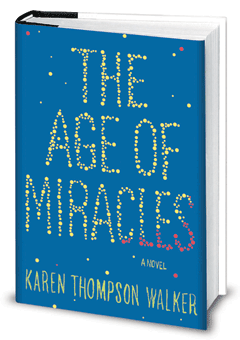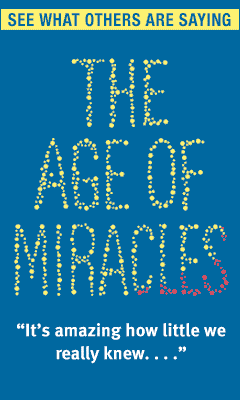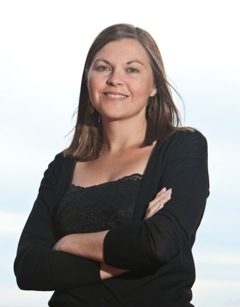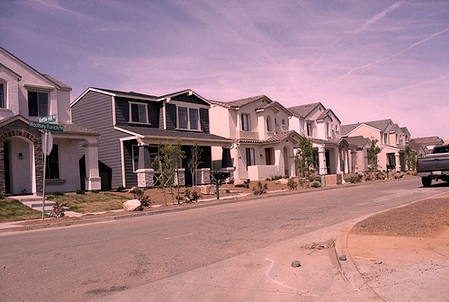The Age of Miracles
by Karen Thompson Walker
In The Age of Miracles, the world is ending just as the life of a young girl is beginning. This tragic coming-of-age story chronicles the parallel disintegrations of the world and the life and family of Julia, a sensitive 12-year-old girl living in a sleepy suburb of California. As apocalypse looms for the earth and its inhabitants, Julia grapples with the twin challenges of survival and growing up--in this instance much too fast.
The earth has suddenly begun to slow in its rotation, extending the length of days and nights. What starts as a minor oddity grows into catastrophe, as the lengthening periods of sunlight and darkness lead to drastic changes in climate. Birds and plants start to die en masse. People begin to develop a mysterious illness that has no cure--and which is possibly fatal. Radiation floods the earth's atmosphere, and the magnetic field of the planet is affected. Food supplies start to become scarce, with even the most common fruits becoming exotic delicacies before they disappear entirely. As disasters multiply, it becomes clear that humans are living on borrowed time.
In the midst of this, Julia is buffeted with the angst of emerging adolescence, which is amplified as a result of the "slowing." It is because of the slowing that Julia's only friend becomes estranged from her, plunging her into isolation. Fear drives a rift between her parents and raises the possibility of divorce. But the terror of the slowing has an additional effect: it intensifies Julia's connection with Seth, the classmate with whom she has fallen in love.
The title of The Age of Miracles is purposefully double-edged in its meaning, as becomes clear early in the novel: "This was middle school, the age of miracles, the time when kids shot up three inches over the summer, where breasts bloomed from nothing, when voices dipped and dove." It is the "age of miracles" in Julia's life, when the adult she is to become has begun to assert itself. But it is also an age of miracles in a different, and much more ironic way, when the behavior of the planet has become terrifyingly unrecognizable. What is most interesting about this dichotomy of meanings is that they can never achieve harmony: Julia's developmental stages are entirely at odds with the earth's destruction. She is growing into a world that will soon have no refuge for her existence.
In her debut novel, Karen Thompson Walker constructs a believable alternate reality in which every detail is accounted for, from the food sources of the irrevocably damaged earth to the societal conflicts that inevitably erupt worldwide. In particular, the conflicts exhibited between those who keep "clock time"--the same timetable as ever, regardless of the earth's rotation—and those who insist on adhering to a life in sync with the sun, is clearly relevant to any discussion of bigotry. The result is a thorough examination of how human nature might respond when faced with the most significant crisis of its existence.
Equally realistic is the depiction of people's stubborn clinging to the rituals of ordinary life in the face of bizarre conditions, even certain death. As the slowing progresses, Julia continues to go to school, and even plans to go to college, despite all evidence pointing to its being useless. Through the imposition of "clock time," the government attempts to preserve the illusion that life is continuing as usual. Even the demonization of people who refuse to keep "clock time" represents a conflict between those who seek to deny the terrifying reality, and those who wish to feel more at ease through the acceptance of it.
Yet more enduring than ritual and routine is the power of love: through some of the worst events of her life--from the looming apocalypse to the disintegration of her parents' marriage--Julia forges a bond with Seth that is stronger than her fear of the future. They find each other after Julia has suffered through prolonged isolation and insecurities--some normal, others accentuated by the events of the slowing--and Seth's mother has died. Coming together from a place of pain, Seth and Julia represent a moment of brightness in a world where such moments are fast fading, making their relationship deeply poignant for the reader.
The Age of Miracles may be most remarkable for what it does not do: it does not extend any hope. The darkness only increases until at last, we bid goodbye to Julia as she stands clear-eyed on the precipice of the end of all things. --Ilana Teitelbaum








 Karen Thompson Walker was born and raised in San Diego, Calif., where The Age of Miracles is set. She studied English and creative writing at UCLA, where she wrote for the Daily Bruin. After college, she worked as a newspaper reporter in the San Diego area before moving to New York City to attend the Columbia University MFA program.
Karen Thompson Walker was born and raised in San Diego, Calif., where The Age of Miracles is set. She studied English and creative writing at UCLA, where she wrote for the Daily Bruin. After college, she worked as a newspaper reporter in the San Diego area before moving to New York City to attend the Columbia University MFA program.  Do you see this book being intended for a young adult audience?
Do you see this book being intended for a young adult audience?